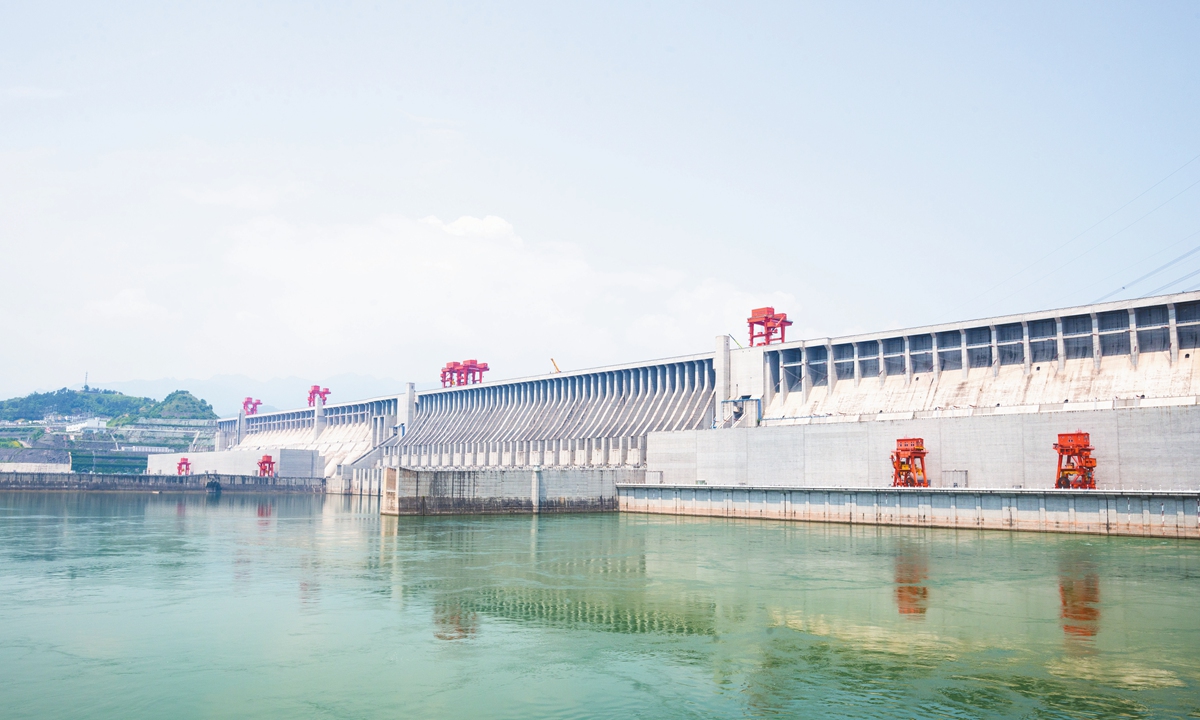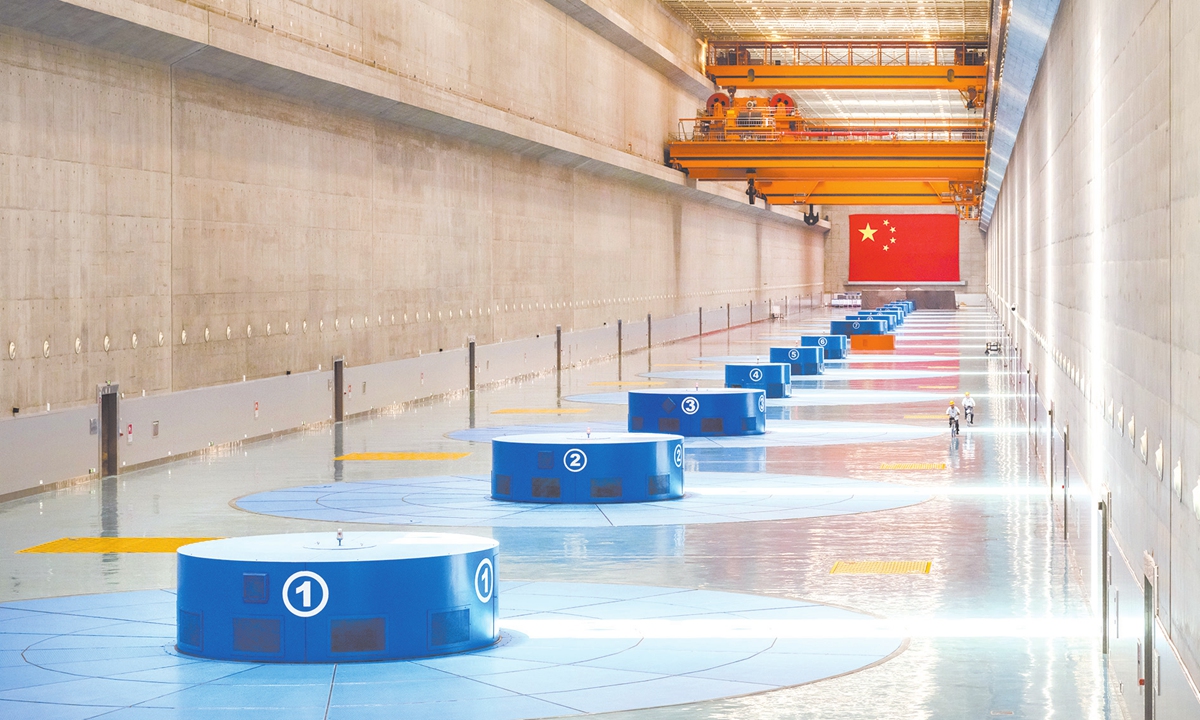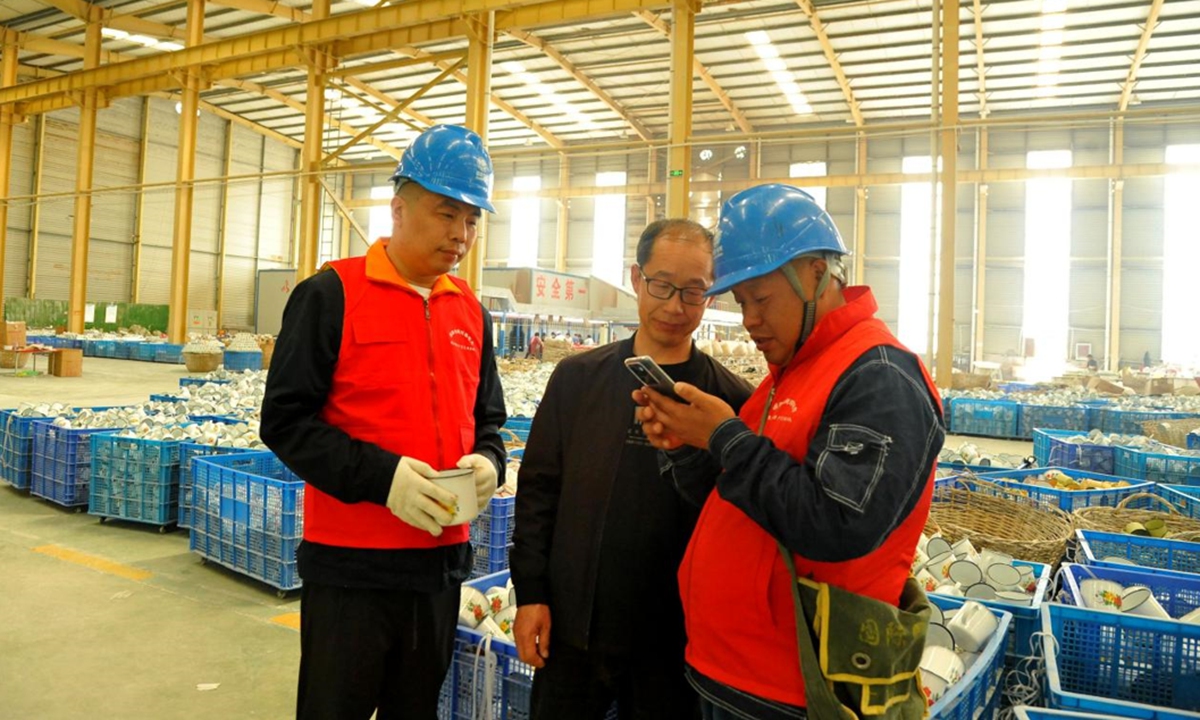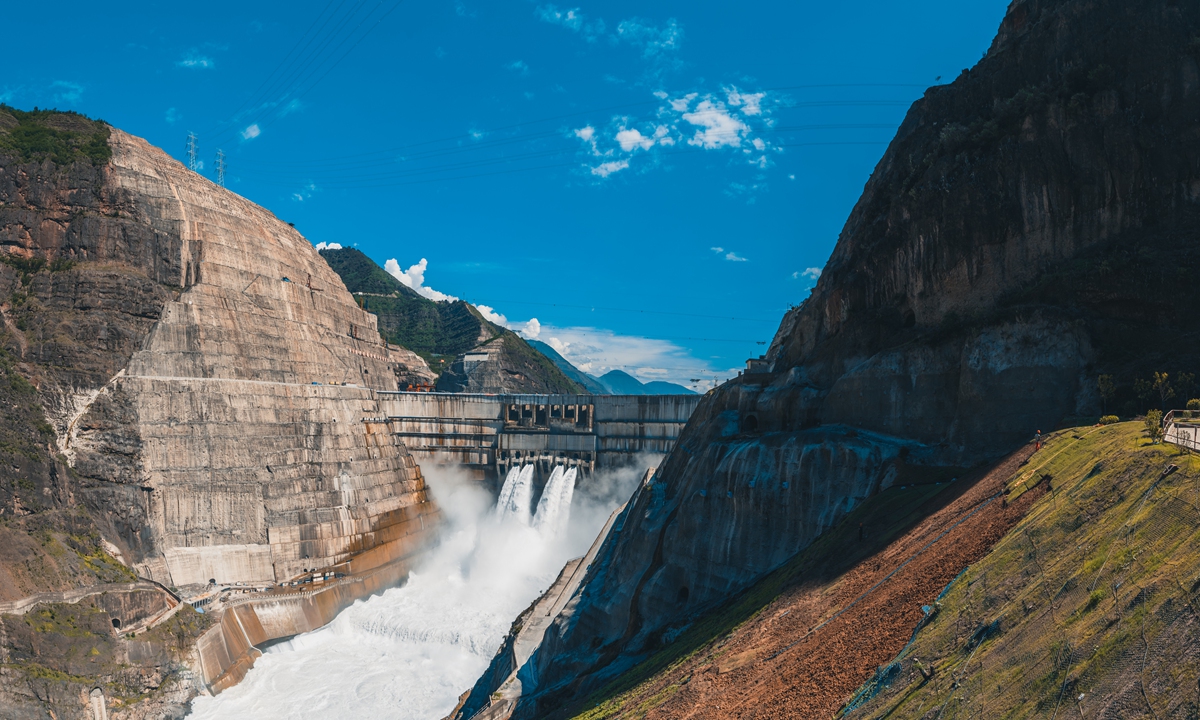World’s largest clean-energy corridor along Yangtze River offers distinctive solution to green transition
Editor's Note:
As the Chinese economy has faced challenges in recent years, some Western officials and media pundits have stepped up their smear campaign against China. They cherry-pick information and distort facts to hype their narratives such as "Peak China," but they always turn a blind eye to China's economic resilience and development potential. In order to set the record straight, the Global Times is launching a multimedia project, including in-depth articles, objective analysis and visual arts, to present a comprehensive and true picture of the economy. This is the ninth installation of the series.

Six mega hydropower stations along the upper and middle reaches of the Yangtze River -Wudongde, Baihetan, Xiluodu, Xiangjiaba, Three Gorges, and Gezhouba - form the world's largest clean-energy corridor, which spans over 1,800 kilometers with a water level drop exceeding 900 meters.
Now, a total of 110 hydroelectric generators are operational in the corridor, which supplies green electricity to Chinese manufacturers and households, setting a good example of sustainable development for other parts of the world in the low-carbon and green transition.
The Global Times recently made a visit to the Gezhouba Dam and the Three Gorges Dam to discover how China's hydropower sector started from scratch to become a global leader.
The Gezhouba Hydropower Station, located in Yichang, Central China's Hubei Province, was the first large-scale water control project on the main artery of the Yangtze River and was a milestone of China's hydropower generation. The first group of generator units was commissioned in 1981 and it has operated for more than 40 years safely.
By 2021, the 40th anniversary of the operation of Gezhouba Hydropower Station, the cumulative power generation exceeded 600 billion kilowatt-hours (kWh), data from China Yangtze Power Co revealed.
The volume of green electricity generated is equivalent to replacing 182.94 million tons of standard coal, reducing carbon dioxide by 499.2 million tons, sulfur dioxide by 96,000 tons, and nitrogen oxide by 107,400 tons, the Global Times has learned.
The power station now possesses 21 power units with a total installed capacity of 2.777 million kilowatts (kW) and an average annual power generation of 15.7 billion kWh, according to official data.
The Gezhouba Hydropower Station continues to play a pivotal role in improving the energy structure in Central China, mitigating the pressure on coal and oil supply, and stepping up the safe operation of power grids in Central China and East China.
Mega water project
After nearly half a century of planning and construction, the world's largest clean-energy corridor was completed in December 2022, with the Baihetan Hydropower Station, located in the upper reaches of the Yangtze River in Southwest China, becoming fully operational.
"The water from the Yangtze River passes through six hydropower stations in turn, which means that every drop of water level is used to produce electricity six times," a manager of the operator at the Baihetan hydropower station told the Global Times.
The manager said that one cubic meter of water can produce 0.25 kWh of green electricity through the Three Gorges Hydroelectric Power Station. With the joint operation of all six hydropower stations, up to 2 kWh of electricity can be produced by one cubic meter of water, which increases operational efficiency by eight-fold.
The total installed capacity of the six hydropower stations has already hit 71.695 million kilowatts, producing about 300 billion kWh of clean electricity annually, which can meet the annual electricity demand of 360 million people, the Global Times has learned.
By February 2024, the cumulative power generation of the six mega hydropower stations exceeded 3.5 trillion kWh, equivalent to saving more than 1 billion tons of standard coal and reducing carbon dioxide by more than 2.8 billion tons, providing strong momentum for China's economic development.
According to calculations based on 713.7 kWh of electricity consumed for every 10,000 yuan of GDP created, the six cascade hydropower stations have created more than 48 trillion yuan ($6.6 trillion) of output value for China's economic development, an industry insider told the Global Times.

Clean and sustainable
As of the end of April this year, China's cumulative installed power generation capacity has reached 3.01 billion kW, an increase of 14.1 percent year-on-year, well ahead of a forecast published in a report by the National Energy Administration (NEA) released in 2022, which said that it expected China's installed power generation capacity is likely to exceed 3 billion kW by the end of 2025.
Hydropower development is among China's ramped up efforts to accelerate the green transition. In recent years, China has devoted itself to boosting the use of sustainable and renewable new energy sources to replace fossil fuels, typically coal.
As a result, in 2023, the installed capacity of renewable energy generation in China historically exceeded that of thermal power generation, according to statistics from the NEA.
Electricity generated by renewable energy accounted for more than one-third of China's total electricity generation in 2023, as the replacement of fossil-fuel powered energy by renewable green energy sources has continued to advance.
The development of renewable energy in China not only provides a solid energy guarantee for domestic economic development, but also contributes Chinese expertise and solutions applicable for the global renewable energy development and other countries' green and low-carbon transformation, analysts said.
More than electricity
As the Yangtze River Basin has become an important part of electricity generation, in June 2023, the "Initiative of E-Yangtze River" was jointly released by the Ministry of Transport and 13 provinces and cities.
The initiative aims to help realize China's dual carbon targets - peaking carbon dioxide emissions by 2030 and achieving carbon neutrality by 2060, and to accelerate the development of clean hydropower in the Yangtze River Basin, as well as renovation of the ships, ports and related industries along the river.
Many new-energy-powered vessels, such as pure electric, hydrogen-fueled and LNG-fueled ships, have been built and are now operating throughout the Yangtze River Basin.
For example, the Yangtze River Three Gorges 1, the world's largest pure electric cruise ship, began commercial operations in Hubei's Yichang on March 31, 2022.
The electric ship is seen being charged at the wharf overnight, with electricity generated from the Three Gorges Hydroelectric Power Station. It can travel 100 kilometers on a single charge, Ye Yong, general manager of the Tourism Development Division at the Three Gorges Tourism Group, the operator Yangtze River Three Gorges 1, told the Global Times.
"Electric ships can also act as huge mobile power banks that store electricity generated at non-peak hours. In the past, without efficient energy storage equipment, electricity generated at night was largely wasted," said Ye.
Aside from power generation, the dams along the Yangtze River also provide room for reverse regulation, navigation improvement and other comprehensive benefits.
The Global Times learned that the six cascade hydropower stations have raised water levels in the upper reaches of the Yangtze River, allowing large cargo ships to enter waterways that were once too shallow to navigate.
In 2023, the Three Gorges hub in Hubei Province transported 172.34 million tons of cargo through water shipment, an increase of 7.95 percent year-on-year, setting a record high, the Global Times has learned.
As the Chinese economy has faced challenges in recent years, some Western officials and media pundits have stepped up their smear campaign against China. They cherry-pick information and distort facts to hype their narratives such as "Peak China," but they always turn a blind eye to China's economic resilience and development potential. In order to set the record straight, the Global Times is launching a multimedia project, including in-depth articles, objective analysis and visual arts, to present a comprehensive and true picture of the economy. This is the ninth installation of the series.

The Three Gorges Dam in Yichang, Central China's Hubei Province on May 22, 2024 Photo: Chen Tao/GT
Six mega hydropower stations along the upper and middle reaches of the Yangtze River -Wudongde, Baihetan, Xiluodu, Xiangjiaba, Three Gorges, and Gezhouba - form the world's largest clean-energy corridor, which spans over 1,800 kilometers with a water level drop exceeding 900 meters.
Now, a total of 110 hydroelectric generators are operational in the corridor, which supplies green electricity to Chinese manufacturers and households, setting a good example of sustainable development for other parts of the world in the low-carbon and green transition.
The Global Times recently made a visit to the Gezhouba Dam and the Three Gorges Dam to discover how China's hydropower sector started from scratch to become a global leader.
The Gezhouba Hydropower Station, located in Yichang, Central China's Hubei Province, was the first large-scale water control project on the main artery of the Yangtze River and was a milestone of China's hydropower generation. The first group of generator units was commissioned in 1981 and it has operated for more than 40 years safely.
By 2021, the 40th anniversary of the operation of Gezhouba Hydropower Station, the cumulative power generation exceeded 600 billion kilowatt-hours (kWh), data from China Yangtze Power Co revealed.
The volume of green electricity generated is equivalent to replacing 182.94 million tons of standard coal, reducing carbon dioxide by 499.2 million tons, sulfur dioxide by 96,000 tons, and nitrogen oxide by 107,400 tons, the Global Times has learned.
The power station now possesses 21 power units with a total installed capacity of 2.777 million kilowatts (kW) and an average annual power generation of 15.7 billion kWh, according to official data.
The Gezhouba Hydropower Station continues to play a pivotal role in improving the energy structure in Central China, mitigating the pressure on coal and oil supply, and stepping up the safe operation of power grids in Central China and East China.
Mega water project
After nearly half a century of planning and construction, the world's largest clean-energy corridor was completed in December 2022, with the Baihetan Hydropower Station, located in the upper reaches of the Yangtze River in Southwest China, becoming fully operational.
"The water from the Yangtze River passes through six hydropower stations in turn, which means that every drop of water level is used to produce electricity six times," a manager of the operator at the Baihetan hydropower station told the Global Times.
The manager said that one cubic meter of water can produce 0.25 kWh of green electricity through the Three Gorges Hydroelectric Power Station. With the joint operation of all six hydropower stations, up to 2 kWh of electricity can be produced by one cubic meter of water, which increases operational efficiency by eight-fold.
The total installed capacity of the six hydropower stations has already hit 71.695 million kilowatts, producing about 300 billion kWh of clean electricity annually, which can meet the annual electricity demand of 360 million people, the Global Times has learned.
By February 2024, the cumulative power generation of the six mega hydropower stations exceeded 3.5 trillion kWh, equivalent to saving more than 1 billion tons of standard coal and reducing carbon dioxide by more than 2.8 billion tons, providing strong momentum for China's economic development.
According to calculations based on 713.7 kWh of electricity consumed for every 10,000 yuan of GDP created, the six cascade hydropower stations have created more than 48 trillion yuan ($6.6 trillion) of output value for China's economic development, an industry insider told the Global Times.

Hydroelectric generator sets at the Three Gorges Dam in Yichang, Central China's Hubei Province on May 22, 2024 Photo: Chen Tao/GT
Clean and sustainable
As of the end of April this year, China's cumulative installed power generation capacity has reached 3.01 billion kW, an increase of 14.1 percent year-on-year, well ahead of a forecast published in a report by the National Energy Administration (NEA) released in 2022, which said that it expected China's installed power generation capacity is likely to exceed 3 billion kW by the end of 2025.
Hydropower development is among China's ramped up efforts to accelerate the green transition. In recent years, China has devoted itself to boosting the use of sustainable and renewable new energy sources to replace fossil fuels, typically coal.
As a result, in 2023, the installed capacity of renewable energy generation in China historically exceeded that of thermal power generation, according to statistics from the NEA.
Electricity generated by renewable energy accounted for more than one-third of China's total electricity generation in 2023, as the replacement of fossil-fuel powered energy by renewable green energy sources has continued to advance.
The development of renewable energy in China not only provides a solid energy guarantee for domestic economic development, but also contributes Chinese expertise and solutions applicable for the global renewable energy development and other countries' green and low-carbon transformation, analysts said.
More than electricity
As the Yangtze River Basin has become an important part of electricity generation, in June 2023, the "Initiative of E-Yangtze River" was jointly released by the Ministry of Transport and 13 provinces and cities.
The initiative aims to help realize China's dual carbon targets - peaking carbon dioxide emissions by 2030 and achieving carbon neutrality by 2060, and to accelerate the development of clean hydropower in the Yangtze River Basin, as well as renovation of the ships, ports and related industries along the river.
Many new-energy-powered vessels, such as pure electric, hydrogen-fueled and LNG-fueled ships, have been built and are now operating throughout the Yangtze River Basin.
For example, the Yangtze River Three Gorges 1, the world's largest pure electric cruise ship, began commercial operations in Hubei's Yichang on March 31, 2022.
The electric ship is seen being charged at the wharf overnight, with electricity generated from the Three Gorges Hydroelectric Power Station. It can travel 100 kilometers on a single charge, Ye Yong, general manager of the Tourism Development Division at the Three Gorges Tourism Group, the operator Yangtze River Three Gorges 1, told the Global Times.
"Electric ships can also act as huge mobile power banks that store electricity generated at non-peak hours. In the past, without efficient energy storage equipment, electricity generated at night was largely wasted," said Ye.
Aside from power generation, the dams along the Yangtze River also provide room for reverse regulation, navigation improvement and other comprehensive benefits.
The Global Times learned that the six cascade hydropower stations have raised water levels in the upper reaches of the Yangtze River, allowing large cargo ships to enter waterways that were once too shallow to navigate.
In 2023, the Three Gorges hub in Hubei Province transported 172.34 million tons of cargo through water shipment, an increase of 7.95 percent year-on-year, setting a record high, the Global Times has learned.



